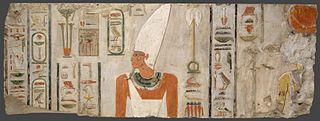
Mentuhotep II, also known under his prenomen Nebhepetre, was an ancient Egyptian pharaoh, the sixth ruler of the Eleventh Dynasty. He is credited with reuniting Egypt, thus ending the turbulent First Intermediate Period and becoming the first pharaoh of the Middle Kingdom. He reigned for 51 years, according to the Turin King List. Mentuhotep II succeeded his father Intef III on the throne and was in turn succeeded by his son Mentuhotep III.
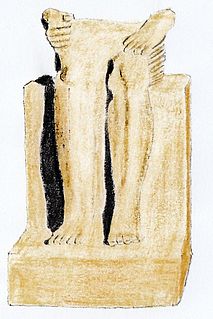
Mentuhotep I may have been a Theban nomarch and independent ruler of Upper Egypt during the early First Intermediate Period. Alternatively, Mentuhotep I may be a fictional figure created during the later Eleventh Dynasty, which rose to prominence under Intef II and Mentuhotep II, playing the role of a founding father.

Sehertawy Intef I was a local nomarch at Thebes during the early First Intermediate Period and the first member of the 11th Dynasty to lay claim to a Horus name. Intef reigned from 4 to 16 years c. 2120 BC or c. 2070 BC during which time he probably waged war with his northern neighbor, the Coptite nomarch Tjauti. Intef was buried in a saff tomb at El-Tarif, known today as Saff el-Dawaba.

Wahankh Intef II was the third ruler of the Eleventh Dynasty of Egypt during the First Intermediate Period. He reigned for almost fifty years from 2112 BC to 2063 BC. His capital was located at Thebes. In his time, Egypt was split between several local dynasties. He was buried in a saff tomb at El-Tarif.
Intef III was the third pharaoh of the Eleventh Dynasty of Egypt during the late First Intermediate Period in the 21st century BC, at a time when Egypt was divided in two kingdoms. The son of his predecessor Intef II and father of his successor Mentuhotep II, Intef III reigned for 8 years over Upper Egypt and extended his domain North against the 10th Dynasty state, perhaps as far north as the 17th nome. He undertook some building activity on Elephantine. Intef III is buried in a large saff tomb at El-Tarif known as Saff el-Barqa.

Senusret I also anglicized as Sesostris I and Senwosret I, was the second pharaoh of the Twelfth Dynasty of Egypt. He ruled from 1971 BC to 1926 BC, and was one of the most powerful kings of this Dynasty. He was the son of Amenemhat I. Senusret I was known by his prenomen, Kheperkare, which means "the Ka of Re is created."

Ankhu was an Egyptian vizier of the early 13th Dynasty, who lived around 1750 BC.

The Theban Tomb TT319 is located in Deir el-Bahari, part of the Theban Necropolis, on the west bank of the Nile, opposite to Luxor. The tomb belongs to the king's wife Neferu II, wife of the ancient Egyptian king Mentuhotep II. Neferu was the daughter of Queen Iah and Intef III.
The Theban Tomb of Meru TT240 is located in El-Assasif, Theban Necropolis. It overlooks the mortuary temple of the 11th Dynasty Pharaoh Mentuhotep II.
Ipi was an Ancient Egyptian vizier of the early Middle Kingdom. His only secure attestation known today is his Theban Tomb (TT315) .The tomb was found in the rocks of Deir el-Bahari overlooking the funerary complex of Mentuhotep II. It consisted of a great courtyard, a corridor, a chapel and a burial chamber. The corridor and chapel were found undecorated and only the burial chamber had painted decorations, religious texts and the titles and name of Ipi on its walls. The burial chamber housed a sarcophagus, sunk into the floor.
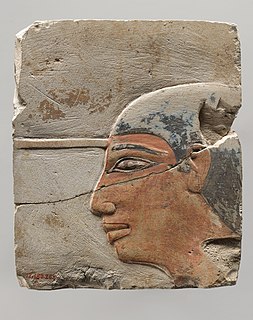
Dagi was an ancient Egyptian vizier during the reign of pharaoh Mentuhotep II of the Eleventh Dynasty.

Siese was a vizier and treasurer of the Twelfth Dynasty of Egypt. He was most likely in office under Senusret III.
Sobekemhat was an ancient Egyptian treasurer under the king Senusret III in the Twelfth Dynasty. Sobekemhat is only known from his mastaba excavated in 1894 next to the pyramid of Senusret III at Dahshur. The mastaba was decorated on the outside with reliefs. These were only found in small fragments, but the fragments record the name and the titles of Sobekemhat. On an offering table he bears the title of the treasurer. The mastaba is in a chain of three mastabas, north of the king's pyramid. It is closest to the pyramid. The next mastaba belongs to the vizier (Nebit) and the third to another high official, perhaps again a vizier. Therefore, it can be argued that Sobekemhat's tomb was the earliest of the three. For a long time it was thought that Sobekemhat was vizier, but the relief fragments with the vizier's title come from the mastaba of Nebit nearby.

Meru was an Ancient Egyptian official under king Mentuhotep II in the Eleventh Dynasty, around 2000 BC. Meru was overseer of sealers at the royal court and therefore one of the highest state officials.

Neferu II was the wife and sister of the ancient Egyptian king Mentuhotep II who ruled in the 11th Dynasty, around 2000 BC.
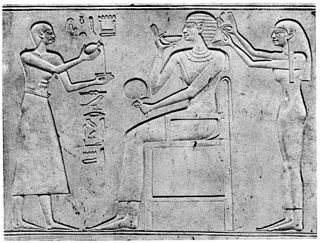
Kawit was an ancient Egyptian queen consort, a lower ranking wife of Pharaoh Mentuhotep II of the 11th Dynasty. Her tomb (DBXI.9) and small decorated chapel were found in her husband's Deir el-Bahari temple complex, behind the main building, along with the tombs of five other ladies, Ashayet, Henhenet, Kemsit, Sadeh and Mayet. She and three other women of the six bore queenly titles, and most of them were priestesses of Hathor, so it is possible that they were buried there as part of the goddess's cult, but it is also possible that they were the daughters of nobles the king wanted to keep an eye upon.

Kemsit was an ancient Egyptian queen consort, the wife of pharaoh Mentuhotep II of the 11th Dynasty. Her tomb (TT308) and small decorated chapel were found in her husband's Deir el-Bahari temple complex, behind the main building, along with the tombs of five other ladies, Ashayet, Henhenet, Kawit, Sadeh and Mayet. Most of them were priestesses of Hathor, so it is possible that they were buried there as part of the goddess's cult, but it is also possible that they were the daughters of nobles the king wanted to keep an eye upon.

The Theban Tomb known as TT308 is located in Deir el-Bahari. It forms part of the Theban Necropolis, situated on the west bank of the Nile opposite Luxor. The tomb is the burial place of the Ancient Egyptian Kemsit, who was King's Beloved Wife, King's Ornament, King's Sole Ornament, Priestess of Hathor during the reign of Mentuhotep II, in the 11th dynasty.
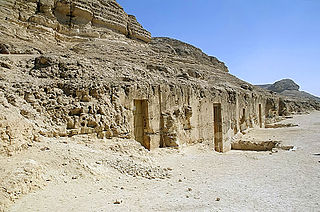
Baqet III was an ancient Egyptian official and Great Chief of the Oryx nome during the 11th Dynasty in the 21st century BCE. Apart from the position of governor of the entire nome, Baqet III also held the titles haty-a, treasurer of the king of Lower Egypt, confidential friend, true royal acquaintance, and mayor of Nekheb.
Mayet is the name of an ancient Egyptian girl buried in the mortuary temple of king Mentuhotep II at Deir el-Bahari. Her burial was found intact. Her position within the royal family of Mentuhotep II is disputed.















